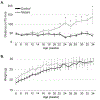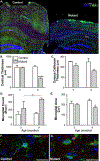Neuronal ablation of mt-AspRS in mice induces immune pathway activation prior to severe and progressive cortical and behavioral disruption
- PMID: 31887305
- PMCID: PMC7448750
- DOI: 10.1016/j.expneurol.2019.113164
Neuronal ablation of mt-AspRS in mice induces immune pathway activation prior to severe and progressive cortical and behavioral disruption
Abstract
Leukoencephalopathy with brainstem and spinal cord involvement and lactate elevation (LBSL) is a rare, slowly progressive white matter disease caused by mutations in the mitochondrial aspartyl-tRNA synthetase (mt-AspRS, or DARS2). While patients show characteristic MRI T2 signal abnormalities throughout the cerebral white matter, brainstem, and spinal cord, the phenotypic spectrum is broad and a multitude of gene variants have been associated with the disease. Here, Dars2 disruption in CamKIIα-expressing cortical and hippocampal neurons results in slowly progressive increases in behavioral activity at five months, and culminating by nine months as severe brain atrophy, behavioral dysfunction, reduced corpus callosum thickness, and microglial morphology indicative of neuroinflammation. Interestingly, RNAseq based gene expression studies performed prior to the presentation of this severe phenotype reveal the upregulation of several pathways involved in immune activation, cytokine production and signaling, and defense response regulation. RNA transcript analysis demonstrates that activation of immune and cell stress pathways are initiated in advance of a behavioral phenotype and cerebral deficits. An understanding of these pathways and their contribution to significant neuronal loss in CamKII-Dars2 deficient mice may aid in deciphering mechanisms of LBSL pathology.
Keywords: DARS2; LBSL; Leukodystrophy; Leukoencephalopathy; Mitochondria; tRNA synthetase.
Copyright © 2020 Elsevier Inc. All rights reserved.
Conflict of interest statement
Declaration of Competing Interest AF is a paid drug safety monitoring board member for Bluebird Bio, Stealth Biotherapeutics, and a paid consultant to Calico Labs.
Figures






References
-
- Agnew T, Goldsworthy M, Aguilar C, Morgan A, Simon M, Hilton H, Esapa C, Wu Y, Cater H, Bentley L, Scudamore C, Poulton J, Morten KJ, Thompson K, He L, Brown SDM, Taylor RW, Bowl MR, Cox RD, 2018. A Wars2 Mutant Mouse Model Displays OXPHOS Deficiencies and Activation of Tissue-Specific Stress Response Pathways. Cell Rep. 25, 3315–3328.e6. 10.1016/j.celrep.2018.11.080 - DOI - PMC - PubMed
-
- Cassiani-Ingoni R, Coksaygan T, Xue H, Reichert-Scrivner SA, Wiendl H, Rao MS, Magnus T, 2006. Cytoplasmic translocation of Olig2 in adult glial progenitors marks the generation of reactive astrocytes following autoimmune inflammation. Exp. Neurol. 201, 349–358. 10.1016/j.expneurol.2006.04.030 - DOI - PubMed
Publication types
MeSH terms
Substances
Grants and funding
LinkOut - more resources
Full Text Sources
Molecular Biology Databases

